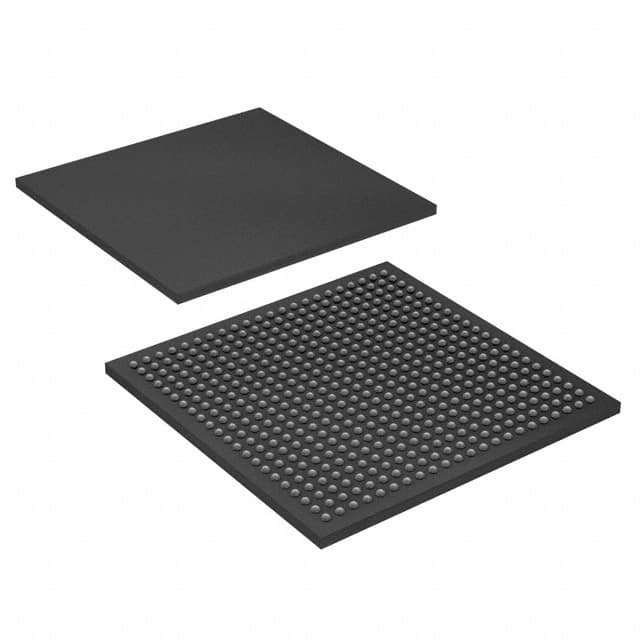Xem thông số kỹ thuật để biết chi tiết sản phẩm.

EP1S20F484C5
Product Overview
- Category: Programmable Logic Device (PLD)
- Use: EP1S20F484C5 is a high-performance PLD designed for various applications in the field of digital logic design.
- Characteristics: It offers advanced features such as high-speed performance, low power consumption, and flexibility in design implementation.
- Package: EP1S20F484C5 comes in a 484-pin FineLine BGA package.
- Essence: The essence of EP1S20F484C5 lies in its ability to provide programmable logic functions that can be customized according to specific application requirements.
- Packaging/Quantity: Each EP1S20F484C5 unit is packaged individually and is available in quantities specified by the manufacturer.
Specifications
- Logic Elements: EP1S20F484C5 consists of 20,000 logic elements, which can be configured as look-up tables, registers, or other combinational or sequential logic components.
- Memory: It includes 1,536 Kbits of embedded memory, which can be used for data storage or as lookup tables.
- Clocking: EP1S20F484C5 supports up to eight global clocks and provides clock management resources for precise timing control.
- I/O Interfaces: It offers a variety of I/O interfaces, including LVDS, SSTL, HSTL, and LVTTL, allowing seamless integration with external devices.
- Operating Voltage: EP1S20F484C5 operates at a voltage range of 1.2V to 3.3V, providing flexibility in different power supply environments.
- Package Size: The FineLine BGA package measures 23mm x 23mm, ensuring compact integration into electronic systems.
Detailed Pin Configuration
EP1S20F484C5 has a total of 484 pins, each serving a specific purpose in the device's functionality. The pin configuration includes dedicated pins for power supply, clock inputs, I/O interfaces, configuration control, and other essential functions. A detailed pinout diagram is provided by the manufacturer to assist in proper integration and utilization of EP1S20F484C5.
Functional Features
- High-Speed Performance: EP1S20F484C5 offers fast operation speeds, enabling efficient execution of complex digital logic designs.
- Flexibility in Design: It provides a wide range of programmable logic elements and memory resources, allowing designers to implement custom logic functions.
- Low Power Consumption: EP1S20F484C5 incorporates power-saving techniques, ensuring efficient energy usage in various applications.
- Clock Management: The device supports multiple clocks and provides advanced clock management features for precise timing control.
- Versatile I/O Interfaces: EP1S20F484C5 supports various I/O standards, facilitating seamless integration with external devices.
Advantages and Disadvantages
Advantages: - High-performance capabilities - Flexibility in design implementation - Low power consumption - Advanced clock management - Versatile I/O interfaces
Disadvantages: - Limited availability of alternative models - Higher cost compared to some lower-end PLDs
Working Principles
EP1S20F484C5 operates based on the principles of programmable logic. It consists of configurable logic elements that can be interconnected to perform desired logic functions. These logic elements are programmed using hardware description languages or specialized software tools. Once programmed, EP1S20F484C5 executes the defined logic operations, providing the desired output based on the input signals received.
Detailed Application Field Plans
EP1S20F484C5 finds applications in various fields where digital logic design is required. Some of the detailed application field plans include: - Telecommunications: EP1S20F484C5 can be used in communication systems for signal processing, protocol handling, and data routing. - Industrial Automation: It enables control and monitoring functions in industrial automation systems, facilitating efficient operation and process management. - Automotive Electronics: EP1S20F484C5 can be utilized in automotive electronics for engine control, driver assistance systems, and infotainment applications. - Consumer Electronics: It finds applications in consumer electronic devices such as gaming consoles, multimedia players, and smart home systems.
Detailed and Complete Alternative Models
While EP1S20F484C5 offers advanced features and performance, it is essential to consider alternative models based on specific requirements. Some alternative PLDs that can be considered are: - EP2S60F1020C5: A higher-capacity PLD with 60,000 logic elements and enhanced memory resources. - EP4CE115F29C7: A cost-effective PLD with 115,000 logic elements and support for various I/O standards. - EP3C25E144C8N
Liệt kê 10 câu hỏi và câu trả lời thường gặp liên quan đến ứng dụng EP1S20F484C5 trong giải pháp kỹ thuật
Sure! Here are 10 common questions and answers related to the application of EP1S20F484C5 in technical solutions:
Q1: What is EP1S20F484C5? A1: EP1S20F484C5 is a specific model of Field-Programmable Gate Array (FPGA) manufactured by Intel.
Q2: What are the key features of EP1S20F484C5? A2: EP1S20F484C5 offers 20,000 logic elements, 484 pins, and operates at a maximum frequency of X MHz.
Q3: What are some typical applications of EP1S20F484C5? A3: EP1S20F484C5 can be used in various applications such as digital signal processing, industrial automation, telecommunications, and embedded systems.
Q4: How do I program EP1S20F484C5? A4: EP1S20F484C5 can be programmed using Hardware Description Languages (HDLs) like VHDL or Verilog, along with design software provided by Intel.
Q5: Can EP1S20F484C5 be reprogrammed after initial programming? A5: Yes, EP1S20F484C5 is a reprogrammable FPGA, allowing you to modify and update the design even after it has been programmed.
Q6: What are the power requirements for EP1S20F484C5? A6: EP1S20F484C5 typically requires a supply voltage of X volts and consumes Y watts of power under normal operating conditions.
Q7: Does EP1S20F484C5 support external memory interfaces? A7: Yes, EP1S20F484C5 supports various memory interfaces such as DDR, SDRAM, and Flash memory for data storage and retrieval.
Q8: Can EP1S20F484C5 communicate with other devices or systems? A8: Yes, EP1S20F484C5 supports various communication protocols like UART, SPI, I2C, and Ethernet, enabling it to interface with other devices or systems.
Q9: Are there any development boards available for EP1S20F484C5? A9: Yes, Intel provides development boards specifically designed for EP1S20F484C5, which include necessary connectors and peripherals for prototyping and testing.
Q10: Where can I find technical documentation and support for EP1S20F484C5? A10: You can find technical documentation, datasheets, reference designs, and support resources on Intel's official website or by contacting their customer support.

